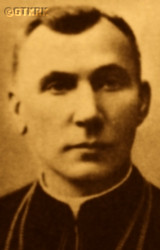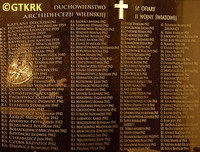Roman Catholic
St Sigismund parish
05-507 Słomczyn
85 Wiślana Str.
Konstancin deanery
Warsaw archdiocese, Poland
full list:
displayClick to display full list

searchClick to search full list by categories
wyświetlKliknij by wyświetlić pełną listę po polsku

szukajKliknij by przeszukać listę wg kategorii po polsku

Martyrology of the clergy — Poland
XX century (1914 – 1989)
personal data
religious status
Servant of God
surname
LUBIANIEC
forename(s)
Charles (pl. Karol)
function
diocesan priest
creed
Latin (Roman Catholic) Church RCmore on
en.wikipedia.org
[access: 2014.09.21]
diocese / province
Vilnius archdiocesemore on
en.wikipedia.org
[access: 2013.05.19]
Vilnius diocesemore on
en.wikipedia.org
[access: 2013.05.19]
academic distinctions
Sacred Theology MA
honorary titles
Prelate‐cantor (Lat. praelati‐cantorus)more on
en.wikipedia.org
[access: 2021.09.17]
(c. 1937 – , St Stanislav the Bishop and Martyr and St Vladislav RC cathedral church, Vilniustoday: Vilnius city dist., Vilnius Cou., Lithuania
more on
en.wikipedia.org
[access: 2022.01.06])
Minor Canonmore on
en.wikipedia.org
[access: 2014.11.14]
(1917 – c. 1935, St Stanislav the Bishop and Martyr and St Vladislav RC cathedral church, Vilniustoday: Vilnius city dist., Vilnius Cou., Lithuania
more on
en.wikipedia.org
[access: 2022.01.06])
„Polonia Restituta” Cross — 4th Class, Officer'smore on
en.wikipedia.org
[access: 2019.04.16]
(02.05.1923)
Gold „Cross of Merit”more on
en.wikipedia.org
[access: 2019.04.16]
(11.11.1937)
date and place
of death
23.07.1942

Vileykatoday: Vileyka dist., Minsk reg., Belarus
more on
en.wikipedia.org
[access: 2022.01.06]
alt. dates and places
of death
28.09.1942
Kasutatoday: Krivoye Selo ssov., Vileyka dist., Minsk reg., Belarus
more on
be.wikipedia.org
[access: 2023.01.18]
details of death
After German and Russian invasion of Poland in 09.1939 and start of the World War II, after start of Russian occupation nominated vicar general for the part of Vilnius diocese incorporated by Russian occupiers into a so‐called Belarus Soviet Republic.
Included in a list of Poles destined for deportation into Siberia but avoided arrest.
After German attack on 22.06.1941 of their erstwhile ally, Russians, travelled to regions beyond pre‐war Polish border without pastoral care for c. 24 years of Russian–Communists rule.
Arrested by the Germans prob. on 22.07.1942 prob. for helping persecuted Jews — prob. during so‐called Polenktion aimed at Polish intelligentsia of mainly Navahrudak region.
Held in Vileyka prison.
The date and place of death uncertain — according to some accounts murdered next day in the prison yard (or in a nearby forest by Kasuta village, c. 9 km from Vileyka, place of mass murders of Vileyka prisoners perpetrated by Russians in 06.1941).
alt. details of death
According to some sources murdered on 28.09.1942.
cause of death
mass murder
perpetrators
Germans
sites and events
VileykaClick to display the description, «Polenaktion» 1942Click to display the description, Help to the JewsClick to display the description, Deportations to SiberiaClick to display the description, Ribbentrop‐MolotovClick to display the description, Pius XI's encyclicalsClick to display the description
date and place
of birth
07.01.1866

Stamerovshchinavillage
today: non‐existent, Dotishki ssov., Voranava dist., Grodno reg., Belarus
more on
be.wikipedia.org
[access: 2023.01.18]
alt. dates and places
of birth
Liubyantsytoday: Dotishki ssov., Voranava dist., Grodno reg., Belarus
more on
be.wikipedia.org
[access: 2023.01.18]
parents
LUBIANIEC Joseph
🞲 ?, ? — 🕆 ?, ?

KOZAKOWSKA Grasylda
🞲 ?, ? — 🕆 ?, ?
presbyter (holy orders)
ordination
31.05.1898

Sankt Petersburgtoday: Saint Petersburg city, Russia
more on
en.wikipedia.org
[access: 2020.07.31]
positions held
1939 – 1942
vicar general — Vilnius RC archdiocese — part of the Archdiocese, which from 1939 was under Russian occupation
c. 1937 – 1942
Prelate‐cantor (Lat. praelati‐cantorus) — Vilniustoday: Vilnius city dist., Vilnius Cou., Lithuania
more on
en.wikipedia.org
[access: 2022.01.06] ⋄ Cathedral Chapter ⋄ St Stanislav the Bishop and Martyr and St Vladislav RC cathedral church
1936 – 1942
dean — Maladzyechnatoday: Maladzyechna dist., Minsk reg., Belarus
more on
en.wikipedia.org
[access: 2022.01.06] RC deanery
1935 – 1942
curatus/rector/expositus — Pliabańtoday: Krasnoe ssov., Maladzyechna dist., Minsk reg., Belarus
more on
be.wikipedia.org
[access: 2023.01.18] ⋄ Assumption of the Blessed Virgin Mary RC church ⋄ Krasnoealso: Krasnoe on Usha river
today: Krasnoe ssov., Maladzyechna dist., Minsk reg., Belarus
more on
be.wikipedia.org
[access: 2023.01.18], Assumption of the Blessed Virgin Mary RC parish ⋄ Maladzyechnatoday: Maladzyechna dist., Minsk reg., Belarus
more on
en.wikipedia.org
[access: 2022.01.06] RC deanery
1917 – c. 1935
Minor Canon — Vilniustoday: Vilnius city dist., Vilnius Cou., Lithuania
more on
en.wikipedia.org
[access: 2022.01.06] ⋄ Cathedral Chapter ⋄ St Stanislav the Bishop and Martyr and St Vladislav RC cathedral church — In turn: Canon‐Theologian (Lat. Canonicus‐Theologus), Canon‐Senior (Lat. Canonicus‐Senior)
1929 – 1935
administrator — Minoitytoday: Tretyakovtsy ssov., Lida dist., Grodno reg., Belarus
more on
be.wikipedia.org
[access: 2023.01.18] ⋄ Sacred Heart of Jesus RC parish ⋄ Lidatoday: Lida dist., Grodno reg., Belarus
more on
en.wikipedia.org
[access: 2021.09.29] RC deanery
1906 – 1935
vice–rector — Vilniustoday: Vilnius city dist., Vilnius Cou., Lithuania
more on
en.wikipedia.org
[access: 2022.01.06] ⋄ Theological Seminary — formally: inspector
1898 – 1935
professor — Vilniustoday: Vilnius city dist., Vilnius Cou., Lithuania
more on
en.wikipedia.org
[access: 2022.01.06] ⋄ Theological Seminary — lecturer (in various periods): Ecclesiastical and Sacred Rites History, , canon law, Latin and Polish languages, sociology, liturgy
founder and organiser — Sacred Heart of Jesus church in Vilnius (1913), semi‐public Immaculate Heart of the Blessed Virgin Mary „Bethany” chapel in Vilnius, Divine Providence church in Vilnius (1928), public Blessed Virgin Mary, Mother of Mercy chapel in Biały Dwór
till c. 1935
social activist — Vilniustoday: Vilnius city dist., Vilnius Cou., Lithuania
more on
en.wikipedia.org
[access: 2022.01.06] — organizer of nurseries and boarding houses for the poor, in particular children and adolescents, schools and workshops for preparation to the profession
c. 1935 – c. 1938
director — Vilniustoday: Vilnius city dist., Vilnius Cou., Lithuania
more on
en.wikipedia.org
[access: 2022.01.06] ⋄ Eucharistic Crusade, Archdiocesan Curia
c. 1927 – c. 1939
director — Vilniustoday: Vilnius city dist., Vilnius Cou., Lithuania
more on
en.wikipedia.org
[access: 2022.01.06] ⋄ Lat. „Pii Operis S. Infantiae Jesus” (Eng. „Pious Work of Child Jesus”), Archdiocesan Curia
c. 1923 – c. 1930
membership — Vilniustoday: Vilnius city dist., Vilnius Cou., Lithuania
more on
en.wikipedia.org
[access: 2022.01.06] ⋄ Lat. „Consilium pro Actione Social” (Eng. „Social Action committee”), Archdiocesan Curia
c. 1922 – c. 1939
censor of religious books (Lat. censores librorum) — Vilniustoday: Vilnius city dist., Vilnius Cou., Lithuania
more on
en.wikipedia.org
[access: 2022.01.06] ⋄ Archdiocesan Curia
c. 1922 – c. 1939
membership — Vilniustoday: Vilnius city dist., Vilnius Cou., Lithuania
more on
en.wikipedia.org
[access: 2022.01.06] ⋄ Lat. „Consilium a Vigilantiae” (Eng. „Committee on Morals”), Archdiocesan Curia
c. 1922 – c. 1938
moderator — Vilniustoday: Vilnius city dist., Vilnius Cou., Lithuania
more on
en.wikipedia.org
[access: 2022.01.06] ⋄ Lat. „Apostolatus Orationis” (Eng. „Prayer Apostolate”) associations, Archdiocesan Curia
c. 1909 – 1931
membership — Vilniustoday: Vilnius city dist., Vilnius Cou., Lithuania
more on
en.wikipedia.org
[access: 2022.01.06] ⋄ Lat. „Consilium ad res Liturgicas” (Eng. „Liturgy committee”), Diocesan Curia
c. 1904
master of ceremonies — Vilniustoday: Vilnius city dist., Vilnius Cou., Lithuania
more on
en.wikipedia.org
[access: 2022.01.06] ⋄ St Stanislav the Bishop and Martyr and St Vladislav RC cathedral church
c. 1904
assessor — Vilniustoday: Vilnius city dist., Vilnius Cou., Lithuania
more on
en.wikipedia.org
[access: 2022.01.06] ⋄ Consistory (i.e. Curia)
from 1898
spiritual father — Vilniustoday: Vilnius city dist., Vilnius Cou., Lithuania
more on
en.wikipedia.org
[access: 2022.01.06] ⋄ Theological Seminary
c. 1894 – 1898
student — Sankt Petersburgtoday: Saint Petersburg city, Russia
more on
en.wikipedia.org
[access: 2020.07.31] ⋄ philosophy and theology, Imperial Roman Catholic Spiritual Academy (1842‐1918) — postgraduate specialised studies crowned with a Sacred Theology Master's degree
from 1889
student — Vilniustoday: Vilnius city dist., Vilnius Cou., Lithuania
more on
en.wikipedia.org
[access: 2022.01.06] ⋄ philosophy and theology, Theological Seminary
others related
in death
HLEBOWICZClick to display biography Henry, JASICKIClick to display biography Vladislav (Fr John of the Cross), LUBECKIClick to display biography Alexander, MALINOWSKIClick to display biography Joseph, MIODUSZEWSKIClick to display biography Anthony, BOHATKIEWICZClick to display biography Mieczyslav, GLAKOWSKIClick to display biography Stanislav, GODLEWSKIClick to display biography Vincent, KASZYRAClick to display biography George, LESZCZEWICZClick to display biography Anthony, MALECClick to display biography Dennis, MARCINIAKClick to display biography Isidore, RYBAŁTOWSKIClick to display biography Casimir, ŚWIATOPEŁK–MIRSKIClick to display biography Anthony, WIECZOREKClick to display biography Vladislav
sites and events
descriptions
Vileyka: During Russian occupation — after German and Russian invasion of Poland in 09.1939 and start of the World War II — largest prison in Vilnius region, originally in the buildings of pre‐war Polish prison, subsequently expanded to buildings of a large hospital. Within the prison grounds Russians perpetrated numerous mass murders on mainly Polish prisoners. It is estimated that c. 1,200 prisoners were buried there. After German attack on 22.06.1941 of their erstwhile ally, Russians, 24.06.1941 Russians initiated forced evacuation of prisoners — part of general genocidal massacres of prisoners ordered by highest Russian authorities — during which 500‐800 prisoners marched off towards Borysów were murdered. Few dozen of them murdered in Kosuta forest, c. 9 km from Vileyka. Later German prison where, as during Russian occupation, mostly Poles were held captive and where mass murders were carried out as well, including a few Polish priests. The murders took place either on the prison yard or in the aforementioned forest n. Kasuta village. (more on: pl.wikipedia.orgClick to attempt to display webpage
[access: 2017.06.16])
«Polenaktion» 1942: In the summer of 1942 in German‐occupied Germ. Generalbezirk Weißruthenien (Eng. General Region of Belarus) — in Nowogródek region among others — Germans carried out «Polenaktion» initiative: the name introduced in a special resolution drafted by Reichssicherheitshauptamt RSHA (Eng. Reich Main Security Office). The action included sacking of all Poles from civilian regional apparatus and police and replacing them with Belarusians. Thousands of Poles were also forcibly deported to Germany as slave labourers. On 26‐30.06.1942 in all counties of the region more than 1,000 representatives of Polish intelligentsia were arrested and subsequently murdered. In Lida region 16 Polish priests were arrested among others. 5 Polish parish priests from Hlybokaye and Pastavy deanery were murdered as well. At the same time Germans set up KL Koldichevo concentration camp n. Baranavichy. The implementation of this genocide project was entrusted to Belarusian collaborationist formations, political, administrative — responsible for preparation of proscription lists — and police, i.e. niem. Weißruthenische Hilfspolizei (Eng. Belarusian Auxiliary Police), supported by Ukrainian, Lithuanian, Latvian and Russian (RONA) collaborators. The action was coordinated with the liquidation of the Jewish ghettos in the Germ. Generalbezirk Weißruthenien.
Help to the Jews: During World War II on the Polish occupied territories Germans forbid to give any support to the Jews under penalty of death. Hundreds of Polish priests and religious helped the Jews despite this official sanction. Many of them were caught and murdered.
Deportations to Siberia: In 1939‐1941 Russians deported — in four large groups in: 10.02.1940, 13‐14.04.1940, 05‐07.1940, 05‐06.1941 — up to 1 mln of Polish citizens from Russian occupied Poland to Siberia leaving them without any support at the place of exile. Thousands of them perished or never returned. The deportations east, deep into Russia, to Siberia resumed after 1944 when Russians took over Poland. (more on: en.wikipedia.orgClick to attempt to display webpage
[access: 2014.09.21])
Ribbentrop‐Molotov: Genocidal Russian‐German alliance pact between Russian leader Joseph Stalin and German leader Adolf Hitler signed on 23.08.1939 in Moscow by respective foreign ministers, Mr. Vyacheslav Molotov for Russia and Joachim von Ribbentrop for Germany. The pact sanctioned and was the direct cause of joint Russian and German invasion of Poland and the outbreak of the World War II in 09.1939. In a political sense, the pact was an attempt to restore the status quo ante before 1914, with one exception, namely the „commercial” exchange of the so‐called „Kingdom of Poland”, which in 1914 was part of the Russian Empire, fore Eastern Galicia (today's western Ukraine), in 1914 belonging to the Austro‐Hungarian Empire. Galicia, including Lviv, was to be taken over by the Russians, the „Kingdom of Poland” — under the name of the General Governorate — Germany. The resultant „war was one of the greatest calamities and dramas of humanity in history, for two atheistic and anti‐Christian ideologies — national and international socialism — rejected God and His fifth Decalogue commandment: Thou shall not kill!” (Abp Stanislav Gądecki, 01.09.2019). The decisions taken — backed up by the betrayal of the formal allies of Poland, France and Germany, which on 12.09.1939, at a joint conference in Abbeville, decided not to provide aid to attacked Poland and not to take military action against Germany (a clear breach of treaty obligations with Poland) — were on 28.09.1939 slightly altered and made more precise when a treaty on „German‐Russian boundaries and friendship” was agreed by the same murderous signatories. One of its findings was establishment of spheres of influence in Central and Eastern Europe and in consequence IV partition of Poland. In one of its secret annexes agreed, that: „the Signatories will not tolerate on its respective territories any Polish propaganda that affects the territory of the other Side. On their respective territories they will suppress all such propaganda and inform each other of the measures taken to accomplish it”. The agreements resulted in a series of meeting between two genocidal organization representing both sides — German Gestapo and Russian NKVD when coordination of efforts to exterminate Polish intelligentsia and Polish leading classes (in Germany called «Intelligenzaktion», in Russia took the form of Katyń massacres) where discussed. Resulted in deaths of hundreds of thousands of Polish intelligentsia, including thousands of priests presented here, and tens of millions of ordinary people,. The results of this Russian‐German pact lasted till 1989 and are still in evidence even today. (more on: en.wikipedia.orgClick to attempt to display webpage
[access: 2015.09.30])
Pius XI's encyclicals: Facing the creation of two totalitarian systems in Europe, which seemed to compete with each other, though there were more similarities than contradictions between them, Pope Pius XI issued in 03.1937 (within 5 days) two encyclicals. In the „Mit brennender Sorge” (Eng. „With Burning Concern”) published on 14.03.1938, condemned the national socialism prevailing in Germany. The Pope wrote: „Whoever, following the old Germanic‐pre‐Christian beliefs, puts various impersonal fate in the place of a personal God, denies the wisdom of God and Providence […], whoever exalts earthly values: race or nation, or state, or state system, representatives of state power or other fundamental values of human society, […] and makes them the highest standard of all values, including religious ones, and idolizes them, this one […] is far from true faith in God and from a worldview corresponding to such faith”. On 19.03.1937, published „Divini Redemptoris” (Eng. „Divine Redeemer”), in which criticized Russian communism, dialectical materialism and the class struggle theory. The Pope wrote: „Communism deprives man of freedom, and therefore the spiritual basis of all life norms. It deprives the human person of all his dignity and any moral support with which he could resist the onslaught of blind passions […] This is the new gospel that Bolshevik and godless communism preaches as a message of salvation and redemption of humanity”… Pius XI demanded that the established human law be subjected to the natural law of God , recommended the implementation of the ideal of a Christian state and society, and called on Catholics to resist. Two years later, National Socialist Germany and Communist Russia came together and started World War II. (more on: www.vatican.vaClick to attempt to display webpage
[access: 2023.05.28], www.vatican.vaClick to attempt to display webpage
[access: 2023.05.28])
sources
personal:
www.glaukopis.plClick to attempt to display webpage
[access: 2012.11.23], www.bialystok.opoka.org.plClick to attempt to display webpage
[access: 2013.01.06], www.magwil.ltClick to attempt to display webpage
[access: 2015.05.09], newsaints.faithweb.comClick to attempt to display webpage
[access: 2021.12.19]
bibliographical:
„Vilnius archdiocese clergy martyrology 1939‐1945”, Fr Thaddeus Krahel, Białystok, 2017
original images:
www.bialystok.opoka.org.plClick to attempt to display webpage
[access: 2013.01.06], www.genealogia.okiem.plClick to attempt to display webpage
[access: 2015.05.09], www.ciekawepodlasie.plClick to attempt to display webpage
[access: 2020.07.31]
LETTER to CUSTODIAN/ADMINISTRATOR
If you have an Email client on your communicator/computer — such as Mozilla Thunderbird, Windows Mail or Microsoft Outlook, described at WikipediaPatrz:
en.wikipedia.org, among others — try the link below, please:
LETTER to CUSTODIAN/ADMINISTRATORClick and try to call your own Email client
If however you do not run such a client or the above link is not active please send an email to the Custodian/Administrator using your account — in your customary email/correspondence engine — at the following address:

giving the following as the subject:
MARTYROLOGY: LUBIANIEC Charles
To return to the biography press below:
 Click to return to biography
Click to return to biography










